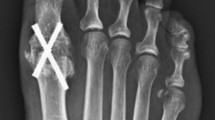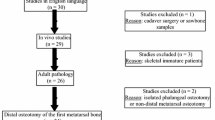Abstract
Background
This study aims to illustrate the results of percutaneous forefoot surgery (PFS) for correction of hallux valgus.
Materials and methods
A prospective study of 108 patients, with hallux valgus deformity, who underwent PFS was conducted. The minimum clinical and radiological follow-up was two years (mean 57.3 months, range 22–112).
Results
Preoperative mean visual analog scale was 6.3 ± 1.5 points, and AOFAS scores were 50.6 ± 11 points. At the last follow-up, both scores improved to 1.9 ± 2.4 points and 85.9 ± 1.83 points, respectively. Mean hallux valgus angle changed from 34.3° ± 9.3° preoperatively to 22.5° ± 11.1° at follow-up. At follow-up, 76.5% of the subjects were satisfied or very satisfied. Recurrence of medial 1st MT head pain happened in 22 cases (16.7%).
Conclusions
PFS, in our study, does not improve the radiological and patient satisfaction rate results compared with conventional procedures. The main advantage is a low postoperative pain level, but with an insufficient HVA correction.
Level of evidence
II, prospective study.

Similar content being viewed by others
References
De Prado M, Ripio PL, Golano P (2003) Hallux valgus. In: Cirugía percutánea del antepie. Barcelona: Masson SA, pp 57–94
Isham SA (1991) The Reverdin-Isham procedure for the correction of hallux abducto valgus. A distal metatarsal osteotomy procedure. Clin Podiatr Med Surg 8(1):81–94
De Lavigne C, de Prado M, Sugar G, Determe P (2007) Hallux valgus and forefoot surgery: mini-invasive or open? In: Symposium 41. 8th EFORT congress, May 13, 2007, Florence Italy. http://www.efort.org/_documents%5CJunior%20Reports%5C3.rapor.pdf. Accessed 10 Oct 2008
Roukis TS (2009) Percutaneous and minimum incisión metatarsal osteotomies: a systematic review. J Foot Ankle Surg 48(3):380–387
Kitaoka HB, Alexander IJ, Adelaar RS, Nunley JA, Meyerson MS, Sanders M (1999) Clinical rating systems for the ankle-hindfoot, midfoot, hallux and lesser toes. Foot Ankle Int 15(7):349–353
Ibrahim T, Beiri A, Azzabi M, Best AJ, Taylos GJ, Menon DK (2007) Reliability and validity of the subjective component of the American Orthopaedic Foot and Ankle Society clinical rating scales. J Foot Ankle Surg 46(2):65–74
Coughlin MJ, Saltzman CL, Nunley JAI (2002) Angular measurements in the evaluation of hallux valgus deformities: a report of the ad hoc committee of the American Orthopaedic Foot and Ankle Society on angular measurements. Foot Ankle Int 23:68–74
Pigott H (1960) The natural history of hallux valgus in adolescent and early adult life. J Bone Joint Surg Am 42:749–760
Kadakia AR, Smerek JP, Myerson MS (2007) Radiographic results after percutaneous distal metatarsal osteotomy for correction of hallux valgus deformity. Foot Ankle Int 28:355–360
Price DD, McGrath PA, Rafii A, Buckingham B (1983) The validation of visual analogue scales as ratio scale measures for chronic and experimental pain. Pain 17(1):45–56
Jensen MP, Karoly P, Braver S (1986) The measurement of clinical pain intensity: a comparison of six methods. Pain 27(1):117–126
Lee JS, Hobden E, Stiell IG, Wells GA (2003) Clinically important change in the visual analog scale after adequate pain control. Acad Emerg Med 10(10):1128–1130
Nikolaou VS, Korres D, Xypnitos F, Lazarettos J, Lallos S, Sapkas G, Efstathopoulos N (2009) Fixation of Mitchell’s osteotomy with bioabsorbable pins for treatment of hallux valgus deformity. Int Orthop 33(3):701–706
Deveci A, Firat A, Yilmaz S, Oken OF, Yildirim AO, Ucaner A, Bozkurt M (2013) Short-term clinical and radiologic results of the scarf osteotomy: what factors contribute to recurrence? J Foot Ankle Surg 52(6):771–775
Aminian A, Kelikian A, Moen T (2006) Scarf osteotomy for hallux valgus deformity: an intermediate follow-up of clinical and radiographic outcomes. Foot Ankle Int 27:883–886
Lee KB, Cho NY, Park HW, Seon JK, Lee SH (2015) A comparison of proximal and distal Chevron osteotomy, both with lateral soft-tissue release, for moderate to severe hallux valgus in patients undergoing simultaneous bilateral correction. Bone Jt J 97B:202–207
Schneider W, Aigner N, Pinggera O, Knahr K (2004) Chevron osteotomy in hallux valgus: ten-year results of 112 cases. J Bone Jt Surg Br 86:1016–1020
Giannini S, Cavallo M, Faldini C, Luciani D, Vannini F (2013) The SERI distal metatarsal osteotomy and Scarf osteotomy provide similar correction of hallux valgus. Clin Orthop Relat Res 471:2305–2311
Frelson M, Gayet LE, Bouche G, Hamcha H, Nebout J, Pries P (2005) Ostetomie Scarf dans le traitement de l’hallux valgus. A propos de 123 cas avec un recul moyen de 4,8 ans. Rev Chir Orthop 91:257–266
Crevoiser X, Mouhsine E, Ortolano V, Udin B, Dutoit M (2001) The Scarf osteotomy for the treatment of hallux valgus deformity: a review of 84 cases. Foot Ankle Int 22:970–976
Bock P, Kluger R, Kirsten K, Mittlbock M, Schuh R, Trnka H (2015) The Scarf osteotomy with minimally invasive lateral release for treatment of hallux valgus deformity. J Bone Jt Surg Am 97:1238–1245
Fakoor M, Sarafan N, Mohammadhoseini P, Khorami M, Arti H, Mosavi S, Aghaeeaghdam A (2014) Comparison of clinical outcomes of Scarf and Chevron osteotomies and the McBride procedure in the treatment of hallux valgus deformity. Arch Bone Jt Surg 2(1):31–36
Bauer T, Lavigne C, Biau D, De Prado M, Isham S, Laffenetre O (2009) Percutaneous hallux valgus surgery: a prospective multicenter study of 189 cases. Orthop Clin N Am 40:505–514
Bauer T, Biau D, Lortat-Jacob A, Ardí P (2010) Percutaneous hallux valgus correction using the Reverdin-Isham osteotomy. Orthop Traumatol Surg Res 96(4):407–416
Lee KB, Hur CI, Chung JY, Juns ST (2009) Outcome of unilateral versus simultaneous correction for hallux valgus. Foot Ankle Int 30(2):120–123
Jones S, Al Hussainy HA, Ali F, Betts RP, Flowers MJ (2004) Scarf osteotomy for hallux valgus. A prospective clinical and pedobarographic study. J Bone Joint Surg Br 86:830–836
Bonnel F, Canovas F, Poiree G, Dusserre F, Vergnes C (1999) Èvaluation de l’ostéotomie Scarf pour hallux valgus en function de l’angle articulaire distal métarsien: etude prospective sur 79 cas operas. Rev Chir Orthop 85:381–386
Easley ME, Trnka HJ (2007) Current concepts review: hallux valgus part II: operative treatment. Foot Ankle Int 28(6):748–758
Trnka HJ, Zembsch A, Easeley ME, Salzer M, Ritschl P, Myerson MS (2000) The chevron osteotomy for correction of hallux valgus. Comparison of findings after two and five years of follow-up. J Bone Jt Surg Am 82:1373–1378
Kilmartin TE, O’Kane C (2010) Combined rotation scarf and Akin osteotomies for hallux valgus: a patient focussed 9 year follow up for 50 patients. J Foot Ankle Res 3:2. doi:10.1186/1757-1146-3-2
Okuda R, Kinoshita M, Yasuda T, Jotoku T, Shima H, Takamura M (2011) Hallux valgus angle as a predictor of recurrence following proximal metatarsal ostoeotomy. J Orthop Sci 16(6):760–764
Lehman DE (2003) Salvage of complications of hallux valgus surgery. Foot Ankle Clin 8(1):15–35
Robison AH, Limbers JP (2005) Modern concepts in the treatment of hallux valgus. J Bone Jt Surg Br 87(8):1038–1045
Torkki M, Seitsalo S, Paavolainen P (2001) Chevron osteotomy for correction of hallux valgus: a long-term follow-up study. Foot 11:91–93
Raikin SM, Miller AG, Daniel J (2014) Recurrence of hallux valgus. A review. Foot Ankle Clin N Am 19:259–274
García-Fernández D, Gil-Garay E, Lora-Pablos D, De la Cruz Bértolo J, Llanos-Alcázar LF (2011) Comparative study of the Weil osteotomy with and without fixation. Foot Ankle Surg 17:103–107
Henry J, Besse JL, Fessy AFCP (2011) Distal osteotomy of the lateral metatarsals: a series of 72 cases comparing the Weil osteotomy and the DMMO percutaneous osteotomy. Orthop Traumatol Surg Res 97S:S57–S65
Bauer T (2014) Percutaneous forefoot surgery. Orthop Traumatol Surg Res 100:S191–S204
Thordason D, Ebramzadeh E, Moorthy M, Lee J, Rudicel S (2005) Correlation of hallux valgus surgical outcome with AOFAS forefoot score and radiological parameters. Foot Ankle Int 26(2):122–127
Author information
Authors and Affiliations
Corresponding author
Ethics declarations
Conflict of interest
The author(s) declared no potential conflicts of interests with respect to the research, authorship and/or publication of this article.
Human and animal rights statement
All procedures performed in studies involving human participants were in accordance with the ethical standards of the institutional and/or national research committee and with the 1964 Helsinki Declaration and its later amendments or comparable ethical standards.
Informed consent
Informed consent was obtained from all individual participants included in the study.
Rights and permissions
About this article
Cite this article
Crespo Romero, E., Peñuela Candel, R., Gómez Gómez, S. et al. Percutaneous forefoot surgery for treatment of hallux valgus deformity: an intermediate prospective study. Musculoskelet Surg 101, 167–172 (2017). https://doi.org/10.1007/s12306-017-0464-1
Received:
Accepted:
Published:
Issue Date:
DOI: https://doi.org/10.1007/s12306-017-0464-1




